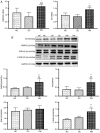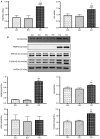Expression of FKBP52 in the ovaries of PCOS rats
- PMID: 30483787
- PMCID: PMC6317667
- DOI: 10.3892/ijmm.2018.3998
Expression of FKBP52 in the ovaries of PCOS rats
Abstract
The present study aimed to examine the expression of FK‑506 binding protein 52 (FKBP52) in the ovary tissues of rats with polycystic ovarian syndrome (PCOS) and its action on mediating androgen receptor (AR) through the mitogen‑activated protein kinase (MAPK)/extracellular signal‑regulated kinase (ERK) pathway. PCOS model rats were established by dehydroepiandrosterone injection. Enzyme‑linked immunosorbent assay (ELISA) measured serum sex hormones. Hematoxylin and eosin (H&E) staining was used to examine histological changes of the ovarian tissues. The expression levels of FKBP52 were detected by immunohistochemical (IHC) staining, reverse transcription‑quantitative polymerase chain reaction (RT‑qPCR) analysis and western blotting (WB). In addition, RT‑qPCR analysis was used to detect the mRNA expression of AR, and WB was used to detect the protein expression levels of AR, ERK1/2 and phosphorylated (p‑)ERK1/2. In granulosa cell (GC) experiments, primary GCs were extracted and cultured. FKBP4 is the FKBP52‑encoding gene, therefore, adenovirus vectors Ad‑Oe‑FKBP4‑EGFP and Ad‑siRNA‑FKBP4‑EGFP were constructed to examine the association among the above factors using the RT‑qPCR and WB methods. In the animal experiment, the vaginal smear, H&E staining and ELISA results showed that the PCOS model was successfully established. The IHC staining revealed that the expression of FKBP52 in the GCs of the PCOS model group was higher than the remaining groups (P<0.01). The mRNA and expression levels of FKBP52 and AR in the PCOS model rats were significantly increased, when compared with levels in the other rats (P<0.05). The expression level of p‑ERK1/2 was also higher (P<0.05). In the GC experiment, following overexpression of the FKBP4 gene, the mRNA and expression levels of FKBP52 and AR were increased (P<0.05). The expression level of p‑ERK1/2 was also increased (P<0.05). Following FKBP4 gene silencing, the mRNA and expression levels of FKBP52 and AR were decreased (P<0.05). The expression level of ERK1/2 was also decreased (P<0.05). However, the expression level of p‑ERK1/2 was increased (P<0.05). In conclusion, the upregulation of co‑chaperone FKBP52 may mediate the activation of AR through the MAPK/ERK pathway.
Figures







Similar articles
-
Expression of SIRT1 in the ovaries of rats with polycystic ovary syndrome before and after therapeutic intervention with exenatide.Int J Clin Exp Pathol. 2015 Jul 1;8(7):8276-83. eCollection 2015. Int J Clin Exp Pathol. 2015. PMID: 26339397 Free PMC article.
-
Physiological role for the cochaperone FKBP52 in androgen receptor signaling.Mol Endocrinol. 2005 Jun;19(6):1654-66. doi: 10.1210/me.2005-0071. Epub 2005 Apr 14. Mol Endocrinol. 2005. PMID: 15831525
-
Association study of androgen signaling pathway genes in polycystic ovary syndrome.Fertil Steril. 2016 Feb;105(2):467-73.e4. doi: 10.1016/j.fertnstert.2015.09.043. Epub 2015 Oct 20. Fertil Steril. 2016. PMID: 26493122 Free PMC article.
-
Basic research in PCOS: are we reaching new frontiers?Reprod Biomed Online. 2014 Jun;28(6):669-83. doi: 10.1016/j.rbmo.2014.02.011. Epub 2014 Mar 4. Reprod Biomed Online. 2014. PMID: 24768413 Review.
-
Regulation of steroid hormone receptor function by the 52-kDa FK506-binding protein (FKBP52).Curr Opin Pharmacol. 2011 Aug;11(4):314-9. doi: 10.1016/j.coph.2011.03.010. Epub 2011 Apr 19. Curr Opin Pharmacol. 2011. PMID: 21511531 Free PMC article. Review.
Cited by
-
Structure and function of the TPR-domain immunophilins FKBP51 and FKBP52 in normal physiology and disease.J Cell Biochem. 2024 Dec;125(12):e30406. doi: 10.1002/jcb.30406. Epub 2023 Apr 23. J Cell Biochem. 2024. PMID: 37087733 Review.
-
Vitamin D Supplementation Improves Uterine Receptivity in a Rat Model of Vitamin D Deficiency: A Possible Role of HOXA-10/FKBP52 Axis.Front Physiol. 2021 Nov 25;12:744548. doi: 10.3389/fphys.2021.744548. eCollection 2021. Front Physiol. 2021. PMID: 34899377 Free PMC article.
-
Transcriptomic analysis of theca cells in a PCOS rat model: insights into follicular development.J Ovarian Res. 2025 Jun 21;18(1):135. doi: 10.1186/s13048-025-01663-w. J Ovarian Res. 2025. PMID: 40544268 Free PMC article.
-
Paeoniflorin attenuates DHEA-induced polycystic ovary syndrome via inactivation of TGF-β1/Smads signaling pathway in vivo.Aging (Albany NY). 2021 Feb 26;13(5):7084-7095. doi: 10.18632/aging.202564. Epub 2021 Feb 26. Aging (Albany NY). 2021. PMID: 33638949 Free PMC article.
-
Integrated Proteotranscriptomics of the Hypothalamus Reveals Altered Regulation Associated with the FecB Mutation in the BMPR1B Gene That Affects Prolificacy in Small Tail Han Sheep.Biology (Basel). 2022 Dec 30;12(1):72. doi: 10.3390/biology12010072. Biology (Basel). 2022. PMID: 36671764 Free PMC article.
References
-
- Asemi Z, Samimi M, Taghizadeh M, Esmaillzadeh A. Effects of Ramadan fasting on glucose homeostasis, lipid profiles, inflammation and oxidative stress in women with polycystic ovary syndrome in Kashan, Iran. Arch Iran Med. 2015;18:806–810. - PubMed
MeSH terms
Substances
LinkOut - more resources
Full Text Sources
Medical
Molecular Biology Databases
Research Materials
Miscellaneous

